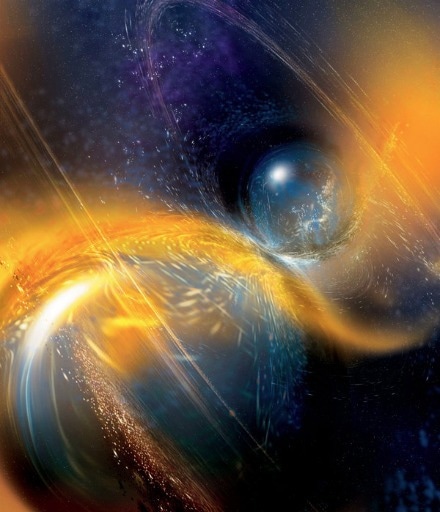Nuclear physicists at RIKEN have measured the likelihood that 20 neutron-rich nuclei would emit neutrons, which has improved models for how heavy elements are produced within stars.
 Figure 1: An illustration depicting two neutron stars merging. Such collisions are believed to be responsible for generating heavy elements by a process known as rapid neutron capture. Measurements by RIKEN researchers on neutron-rich nuclei have helped tighten models of element production by this process. Image Credit: NATIONAL SCIENCE FOUNDATION/LIGO/SONOMA STATE UNIVERSITY/A. SIMONNET/SCIENCE PHOTO LIBRARY
Figure 1: An illustration depicting two neutron stars merging. Such collisions are believed to be responsible for generating heavy elements by a process known as rapid neutron capture. Measurements by RIKEN researchers on neutron-rich nuclei have helped tighten models of element production by this process. Image Credit: NATIONAL SCIENCE FOUNDATION/LIGO/SONOMA STATE UNIVERSITY/A. SIMONNET/SCIENCE PHOTO LIBRARY
Stars produce energy by fusing the nuclei of light elements, beginning with hydrogen nuclei and progressing to heavier nuclei when the hydrogen and other lighter elements are consumed. Nevertheless, this method can only generate the first 26 elements up to iron.
Another mechanism, known as rapid neutron capture, is theorized to yield heavier-than-iron nuclei. As the name implies, this process involves nuclei expanding by quickly absorbing stray neutrons.
It demands extremely high neutron concentrations and is consequently considered to occur mostly during events like neutron star mergers and supernova explosions.
Rapid neutron capture creates neutron-rich elements, but beta-delayed neutron emission is another mechanism by which these elements can lose neutrons.
The ultimate goal of astrophysicists is to create models that can correctly represent the natural abundances that naturally exist in the universe. They have to combine astrophysical observations with laboratory nuclei measurements to do this.
Now, Shunji Nishimura and his colleagues at the RIKEN Nishina Center for Accelerator-Based Science have calculated the probability that 20 neutron-rich nuclei would emit one or two neutrons.
The scientists used the RIKEN Radioactive Isotope Beam Factory, one of just a few facilities in the world capable of performing such measurements, accelerating massive uranium nuclei to nearly 70% of the speed of light and smashing them against beryllium, which created unstable nuclei via a fission process. They then calculated the chances of neutron emission when these unstable nuclei disintegrated.
When the findings were fed into models that estimate element abundances, they enhanced their agreement with observed abundances in the Solar System.
These observations are crucial for tightening up theoretical models of element creation, eliminating roughly 30% of their inherent uncertainty.
While we still have a long way to go before, we can determine the natural abundances of the elements, our measurements have helped close in on the fine structure in the region of elements near tin, which is determined by the so-called freeze-out time of rapid neutron capture. So, we are very close to having a good understanding of this part of the nuclei chart.
Shunji Nishimura, Researcher, RIKEN
The researchers will now investigate the influence of around 200 delayed neutrons on the synthesis of elements up to bismuth via rapid neutron capture.
Journal Reference:
Phong, V. H., et al. (2023) β-delayed one and two neutron emission probabilities southeast of 132Sn and the odd-even systematics in r-process nuclide abundances. Physical Review Letters. doi:10.1103/PhysRevLett.129.172701